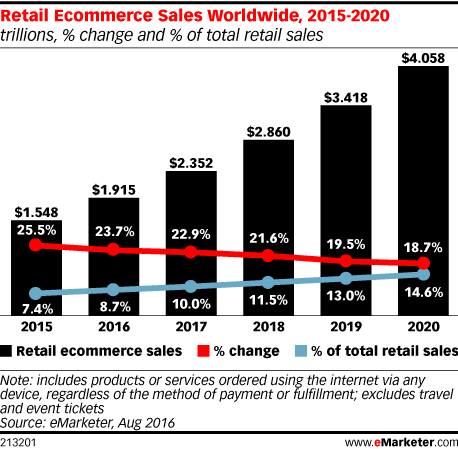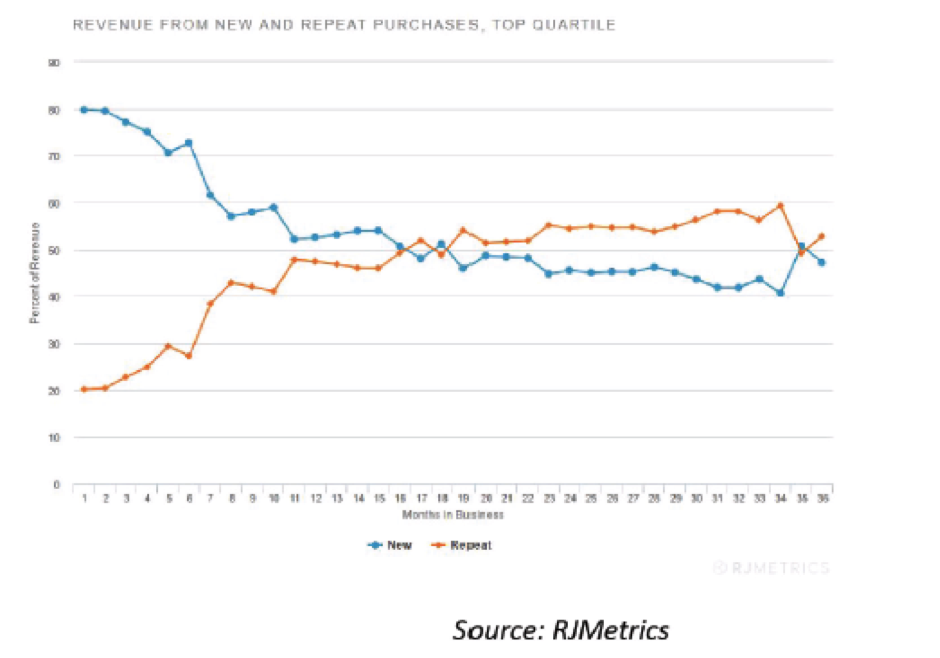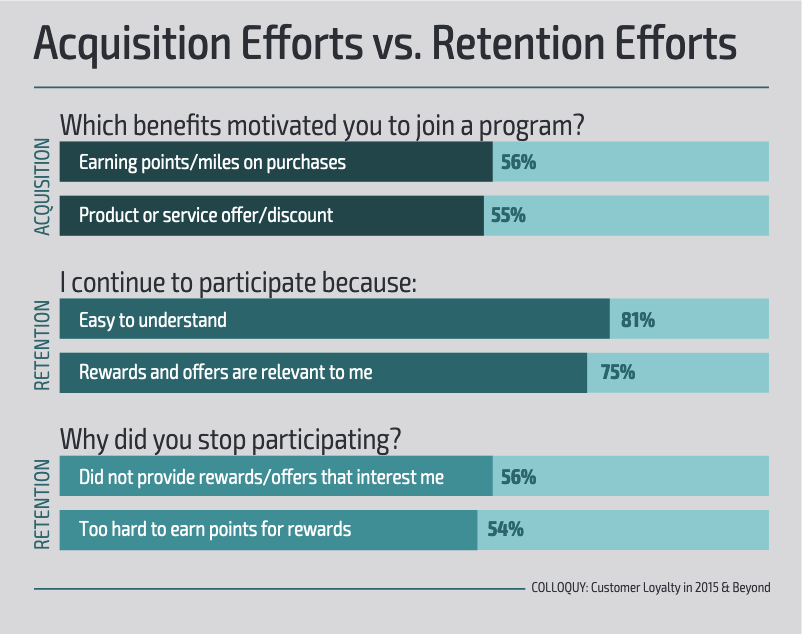DPO White Papers
The Guide To Building Customer Loyalty For eCommerce Businesses
eCommerce Adapts and Grows
It has been less than a quarter of a century since retail sales were first offered online. The first documented secure online purchase was a Sting album, bought for $12.48 in 1994 followed immediately by Pizza Hut’s “PizzaNet”. eCommerce giant Amazon was introduced in 1995, while total online retail sales surpassed $1 billion in 1996, and the rest, as they say is history.
A mere 23 years after the first online sales, the global retail eCommerce market is projected to reach $2.35 trillion this year, representing 10% of all retail purchases. Over half (54%) of all shoppers make their purchases online, on a weekly or monthly basis according to Price Waterhouse Coopers 2016

One of the interesting developments of late, is the move of from pure-play online stores to brick-and-mortar locations, for many leading eCommerce players. Considered actually a method to grow online traffic and sales, some 20 online companies have opened a physical presence in the US, the most notable, Amazon, in November 2016.
The Lack of Loyalty Challenge
With millions of online retailers to compete with (46 million globally, according to Morgan Stanley), it is not surprising that eCommerce businesses are continuously striving to differentiate themselves. Online players opening a physical store, while counterintuitive, is a brilliant example of how e-tailers are implementing the increasingly popular omnichannel approach thereby offering a seamless experience to their customers, across a variety of channels.
One of the clear challenges e-tailers face, is the sheer abundance of data today’s customer can access. Whereas in the past, stores could count on their customers getting into their cars and driving to their favorite retailer, the ease with which customers shift their patronage today is astounding. Price comparison sites guide shoppers to the best deal. Star ratings move them from the cheapest offer to the optimal offer, at the best supplier, with 78% of US consumers consulting reviews before completing a purchase.
Even more concerning, any glitch in the eCommerce experience could lead to abandoned shopping carts, with customers moving to a competing site in the blink of an eye, or the click of a mouse. Unsatisfied customers will likely not return and often take the time to post negative reviews.
This lack of loyalty is one of the main concerns of eCommerce businesses. A staggering 90% of smartphone users are unsure of which brand they plan to purchase when they start a search, according to Google, and one in three deviated from the brand they thought they would buy from, leaving paltry few loyal online shoppers
Key Methods to Build Customer Loyalty
Despite the apparent fickleness of online shopper, top eCommerce sites, see 20% of their revenues from repeat customers within one month of activity, moving towards 40-60% within three years according to the RJ Metrics 2016 eCommerce Investor Report. As they continuously increase their reach, this translates into significant revenues and sales. Considering it is significantly cheaper to retain a customer than acquire a new one, eCommerce businesses must find a way to increase loyalty amongst their customers.
The following are key strategies to enhance loyalty for eCommerce companies:
Implement an Omnichannel Strategy
Today’s shopper wants to shop where they want and how they want, seamlessly. At the minimum, this means recognizing your customers over different devices, and allowing them to continue shopping from where they left off. As seen above, however, omnichannel today could also mean integrating a brick-and-mortar flagship store, as well. This has been highly successful for men’s clothing retailer, Bonobos, who offers “Guideshops” in 30 US locations. Customers can visit the stores, try on clothing, and receive assistance from a trained “guide”. Orders are performed online, clothing is shipped, saving on inventory management and a fully staffed store. Customers enjoy one-on-one service, while saving time by completing their purchase online, as well as enjoying leaving the store hands free.
Personalization is Crucial
A key tactic for building trust is getting to know your customers, personally. This means gathering data from various sources, performing deep analytics on your customer, learning your customer’s preferences, and catering to these preferences.
When combined with omnichannel, this is a very strong marketing tool. Personalization enables targeting your customers where they are likely to be found online, with products and deals that most appeal to them. This could be anything from a special discount email sent to them on their birthday, to targeted Facebook ads for products they are likely to need. For example, a simple search for a vacation destination on TripAdvisor will likely result in targeted ads from Booking.com for hotels in that destination in the user’s personal feed on Facebook.
Beyond targeting your customers, it is important to maintain a personal relationship, by sending thank you emails for site visits or purchases, and incentives for return purchases, as well as occasionally reaching out to remind them of your products and offers.
Exemplary Customer Service
With the multitude of competitors out there, one of the easiest ways to lose a customer is to be unresponsive or provide just “OK” customer service. When a customer contacts you with a question whether via your Facebook page or website, it is of utmost importance they receive an answer — fast.
Offer live chats, or at the least send out an automated message expressing that a request has been received, and that a service representative will respond within a specified time frame. Make sure that you uphold this level of service. Entrepreneur.com cites Swanson Health Products as a leading online e-tailer in terms of customer service, providing email responses between 6 to 12 hours, and an average of up to 2-minute waits on phone calls. They also offer a 12-month return policy.
eCommerce businesses must deal with complaints effectively, always remembering that a bad experience will likely be broadcast across review sites, and on your Facebook page, which can be quite costly. Respond graciously and find a solution, which will satisfy your customer, instill a feeling of trust, and eliminate the chance of negative reviews. Customers who feel they were dealt with fairly, are likely to consider a repeat purchase.
Integrate Loyalty Programs
When combined with personalization and omnichannel strategies, loyalty programs are a strong tool for eCommerce sites. A 2016 study carried out by Accenture Interactive has found to loyalty program members generate between 12 and 18% more revenue than non-members.
Utilize a rewards loyalty program to create a win-win situation for you and your customers. You can gain a loyal customer and encourage return visits simply by giving your customers something significant to them or points that they can redeem for something they desire.
The most popular eCommerce loyalty programs offer members discounts on future purchases, based on points accumulated, such as Nordstrom’s Rewards or Gilt’s tier-based Insider Points. Keep in mind that successful programs are easy to understand, offering relevant rewards and offers.
eCommerce Guide image
A Seamless and Secure Payment Experience
Satisfied customers are repeat customers. The entire shopping experience must be a positive one, from site browsing and search, through to checkout. Integrating a flexible eCommerce payment solution can go a long way to increasing customer satisfaction. A good payment service provider (PSP) will offer a variety of payment methods from international and local credit card receipt to mobile payments and ewallets.
Additionally, leading PSPs will allow customers to pay in their local currency via dynamic currency conversion. Finally, always use a PCI DSS Level 1 certified PSP that meets the international standards customers expect when purchasing online. When customers see payment methods and security icons they recognize, they feel comfortable and secure, while flexibility in payment methods and currencies encourages completing the purchase and return visits. With 46.1% of US cart abandonment found to be at the payment stage, it is crucial to make this stage as seamless as possible, while instilling trust in the customer.
How African eCommerce Businesses Can Encourage Loyalty
By 2025, 50% of the African population will have internet access, and eCommerce is projected to make up 10% of all retail in that year, according to McKinsey. African eCommerce businesses will enjoy the high growth rates projected for this market.
With the potential of building a strong reputation from the outset, African e-tailers would do well to implement the above strategies for personalized eCommerce relationships with their customers, building loyalty from the outset. The above suggestions translate easily to African eCommerce businesses:
- Implement technologies which support multiple channels, such as sites that support both mobile and PC-based browsing and shopping.
- Gather and analyze customer data. Offer a personalized experience to your customers by reaching out and targeting them with products that suit their profiles.
- Define a security level agreement (SLA) and implement it. Make sure all employees are familiar with its terms, and uphold it religiously.
- Create a loyalty program that offers monetary incentives and points to your customers for return purchases.
- Integrate a PCI DSS Level 1 certified PSP that offers mobile payments and supports multiple currencies and cross border payments, which are crucial for success in African eCommerce.



